UNCC300 - Common Good: A Critical Analysis of Ageism in Healthcare
VerifiedAdded on 2023/03/23
|5
|1096
|42
Essay
AI Summary
This essay critically analyzes the challenges in realizing the aspirations of the common good in the context of ageism within the healthcare system. It begins by defining the common good and its relevance to healthcare, particularly concerning the treatment of older adults. The essay highlights how ageism, manifested through stereotypes and discrimination, impacts the well-being and health of older individuals, creating barriers to health equality. It discusses the growing prevalence of ageism globally, referencing Japan's aging population and the increasing reports of age-related prejudice. The essay further explores instances of ageism among healthcare providers and emphasizes the need for training to incorporate common good principles into their practice, advocating for communication strategies that address patients' concerns and ensure individualized care. The document is available on Desklib, a platform offering study tools and resources for students.
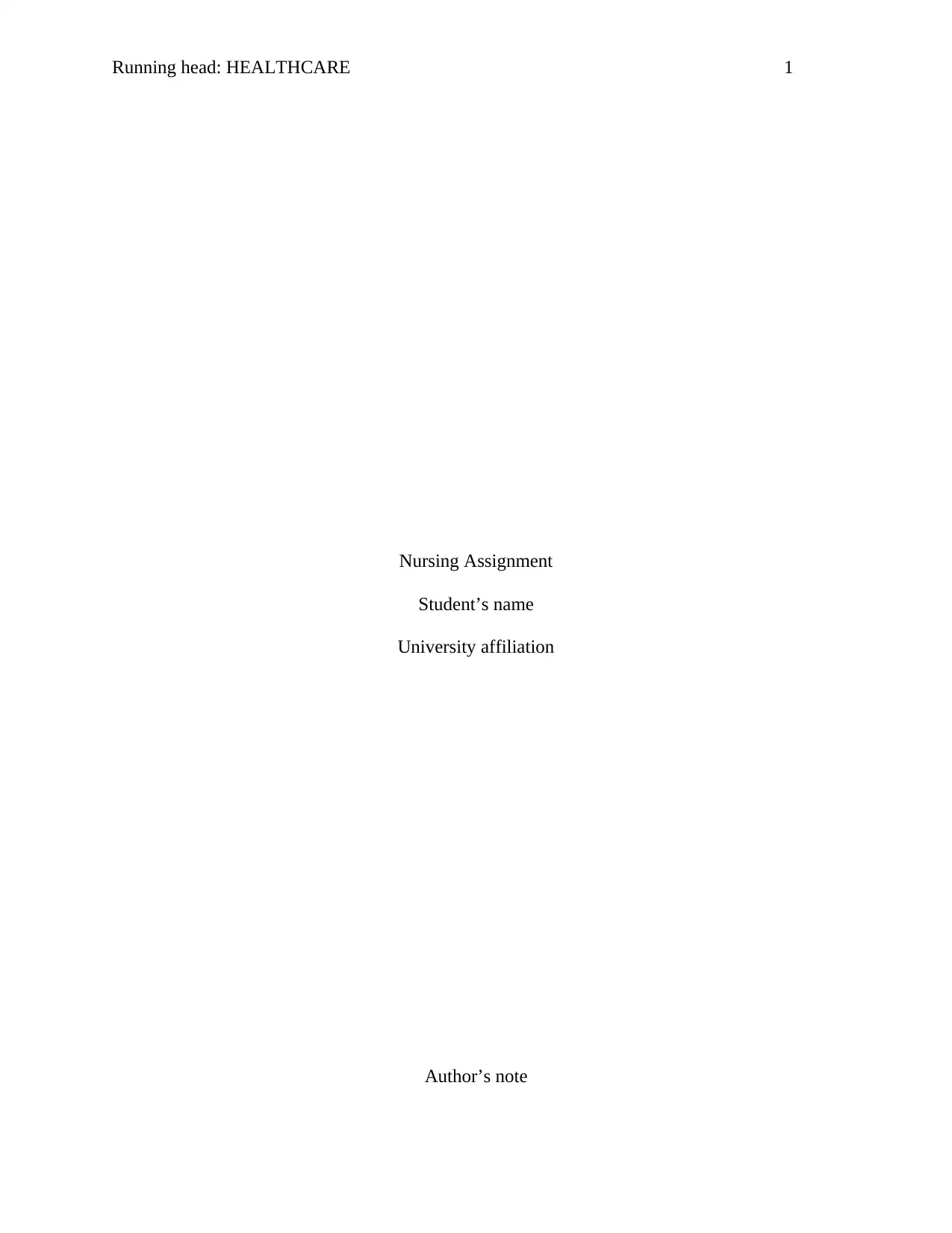
Running head: HEALTHCARE 1
Nursing Assignment
Student’s name
University affiliation
Author’s note
Nursing Assignment
Student’s name
University affiliation
Author’s note
Paraphrase This Document
Need a fresh take? Get an instant paraphrase of this document with our AI Paraphraser
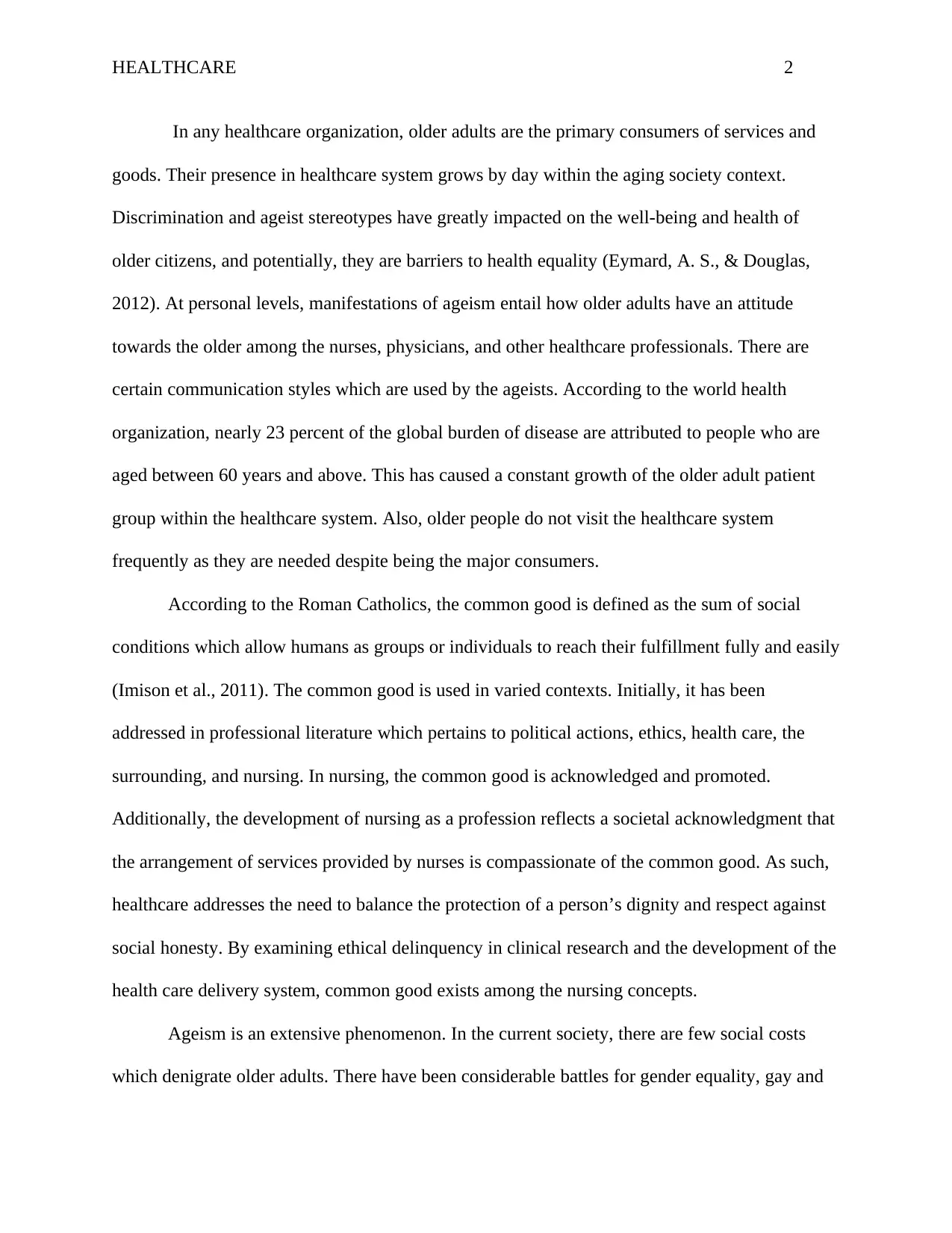
HEALTHCARE 2
In any healthcare organization, older adults are the primary consumers of services and
goods. Their presence in healthcare system grows by day within the aging society context.
Discrimination and ageist stereotypes have greatly impacted on the well-being and health of
older citizens, and potentially, they are barriers to health equality (Eymard, A. S., & Douglas,
2012). At personal levels, manifestations of ageism entail how older adults have an attitude
towards the older among the nurses, physicians, and other healthcare professionals. There are
certain communication styles which are used by the ageists. According to the world health
organization, nearly 23 percent of the global burden of disease are attributed to people who are
aged between 60 years and above. This has caused a constant growth of the older adult patient
group within the healthcare system. Also, older people do not visit the healthcare system
frequently as they are needed despite being the major consumers.
According to the Roman Catholics, the common good is defined as the sum of social
conditions which allow humans as groups or individuals to reach their fulfillment fully and easily
(Imison et al., 2011). The common good is used in varied contexts. Initially, it has been
addressed in professional literature which pertains to political actions, ethics, health care, the
surrounding, and nursing. In nursing, the common good is acknowledged and promoted.
Additionally, the development of nursing as a profession reflects a societal acknowledgment that
the arrangement of services provided by nurses is compassionate of the common good. As such,
healthcare addresses the need to balance the protection of a person’s dignity and respect against
social honesty. By examining ethical delinquency in clinical research and the development of the
health care delivery system, common good exists among the nursing concepts.
Ageism is an extensive phenomenon. In the current society, there are few social costs
which denigrate older adults. There have been considerable battles for gender equality, gay and
In any healthcare organization, older adults are the primary consumers of services and
goods. Their presence in healthcare system grows by day within the aging society context.
Discrimination and ageist stereotypes have greatly impacted on the well-being and health of
older citizens, and potentially, they are barriers to health equality (Eymard, A. S., & Douglas,
2012). At personal levels, manifestations of ageism entail how older adults have an attitude
towards the older among the nurses, physicians, and other healthcare professionals. There are
certain communication styles which are used by the ageists. According to the world health
organization, nearly 23 percent of the global burden of disease are attributed to people who are
aged between 60 years and above. This has caused a constant growth of the older adult patient
group within the healthcare system. Also, older people do not visit the healthcare system
frequently as they are needed despite being the major consumers.
According to the Roman Catholics, the common good is defined as the sum of social
conditions which allow humans as groups or individuals to reach their fulfillment fully and easily
(Imison et al., 2011). The common good is used in varied contexts. Initially, it has been
addressed in professional literature which pertains to political actions, ethics, health care, the
surrounding, and nursing. In nursing, the common good is acknowledged and promoted.
Additionally, the development of nursing as a profession reflects a societal acknowledgment that
the arrangement of services provided by nurses is compassionate of the common good. As such,
healthcare addresses the need to balance the protection of a person’s dignity and respect against
social honesty. By examining ethical delinquency in clinical research and the development of the
health care delivery system, common good exists among the nursing concepts.
Ageism is an extensive phenomenon. In the current society, there are few social costs
which denigrate older adults. There have been considerable battles for gender equality, gay and
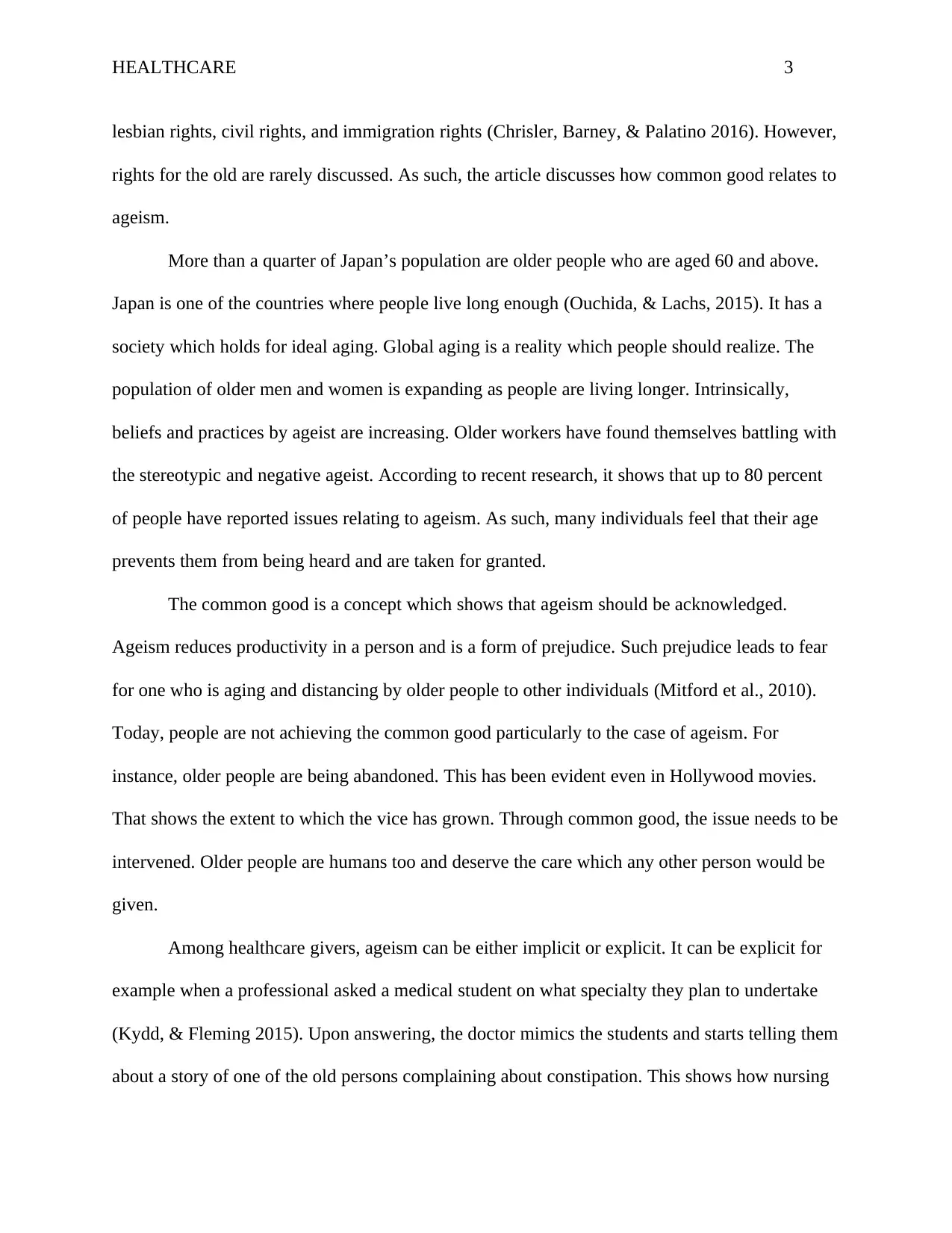
HEALTHCARE 3
lesbian rights, civil rights, and immigration rights (Chrisler, Barney, & Palatino 2016). However,
rights for the old are rarely discussed. As such, the article discusses how common good relates to
ageism.
More than a quarter of Japan’s population are older people who are aged 60 and above.
Japan is one of the countries where people live long enough (Ouchida, & Lachs, 2015). It has a
society which holds for ideal aging. Global aging is a reality which people should realize. The
population of older men and women is expanding as people are living longer. Intrinsically,
beliefs and practices by ageist are increasing. Older workers have found themselves battling with
the stereotypic and negative ageist. According to recent research, it shows that up to 80 percent
of people have reported issues relating to ageism. As such, many individuals feel that their age
prevents them from being heard and are taken for granted.
The common good is a concept which shows that ageism should be acknowledged.
Ageism reduces productivity in a person and is a form of prejudice. Such prejudice leads to fear
for one who is aging and distancing by older people to other individuals (Mitford et al., 2010).
Today, people are not achieving the common good particularly to the case of ageism. For
instance, older people are being abandoned. This has been evident even in Hollywood movies.
That shows the extent to which the vice has grown. Through common good, the issue needs to be
intervened. Older people are humans too and deserve the care which any other person would be
given.
Among healthcare givers, ageism can be either implicit or explicit. It can be explicit for
example when a professional asked a medical student on what specialty they plan to undertake
(Kydd, & Fleming 2015). Upon answering, the doctor mimics the students and starts telling them
about a story of one of the old persons complaining about constipation. This shows how nursing
lesbian rights, civil rights, and immigration rights (Chrisler, Barney, & Palatino 2016). However,
rights for the old are rarely discussed. As such, the article discusses how common good relates to
ageism.
More than a quarter of Japan’s population are older people who are aged 60 and above.
Japan is one of the countries where people live long enough (Ouchida, & Lachs, 2015). It has a
society which holds for ideal aging. Global aging is a reality which people should realize. The
population of older men and women is expanding as people are living longer. Intrinsically,
beliefs and practices by ageist are increasing. Older workers have found themselves battling with
the stereotypic and negative ageist. According to recent research, it shows that up to 80 percent
of people have reported issues relating to ageism. As such, many individuals feel that their age
prevents them from being heard and are taken for granted.
The common good is a concept which shows that ageism should be acknowledged.
Ageism reduces productivity in a person and is a form of prejudice. Such prejudice leads to fear
for one who is aging and distancing by older people to other individuals (Mitford et al., 2010).
Today, people are not achieving the common good particularly to the case of ageism. For
instance, older people are being abandoned. This has been evident even in Hollywood movies.
That shows the extent to which the vice has grown. Through common good, the issue needs to be
intervened. Older people are humans too and deserve the care which any other person would be
given.
Among healthcare givers, ageism can be either implicit or explicit. It can be explicit for
example when a professional asked a medical student on what specialty they plan to undertake
(Kydd, & Fleming 2015). Upon answering, the doctor mimics the students and starts telling them
about a story of one of the old persons complaining about constipation. This shows how nursing
⊘ This is a preview!⊘
Do you want full access?
Subscribe today to unlock all pages.

Trusted by 1+ million students worldwide
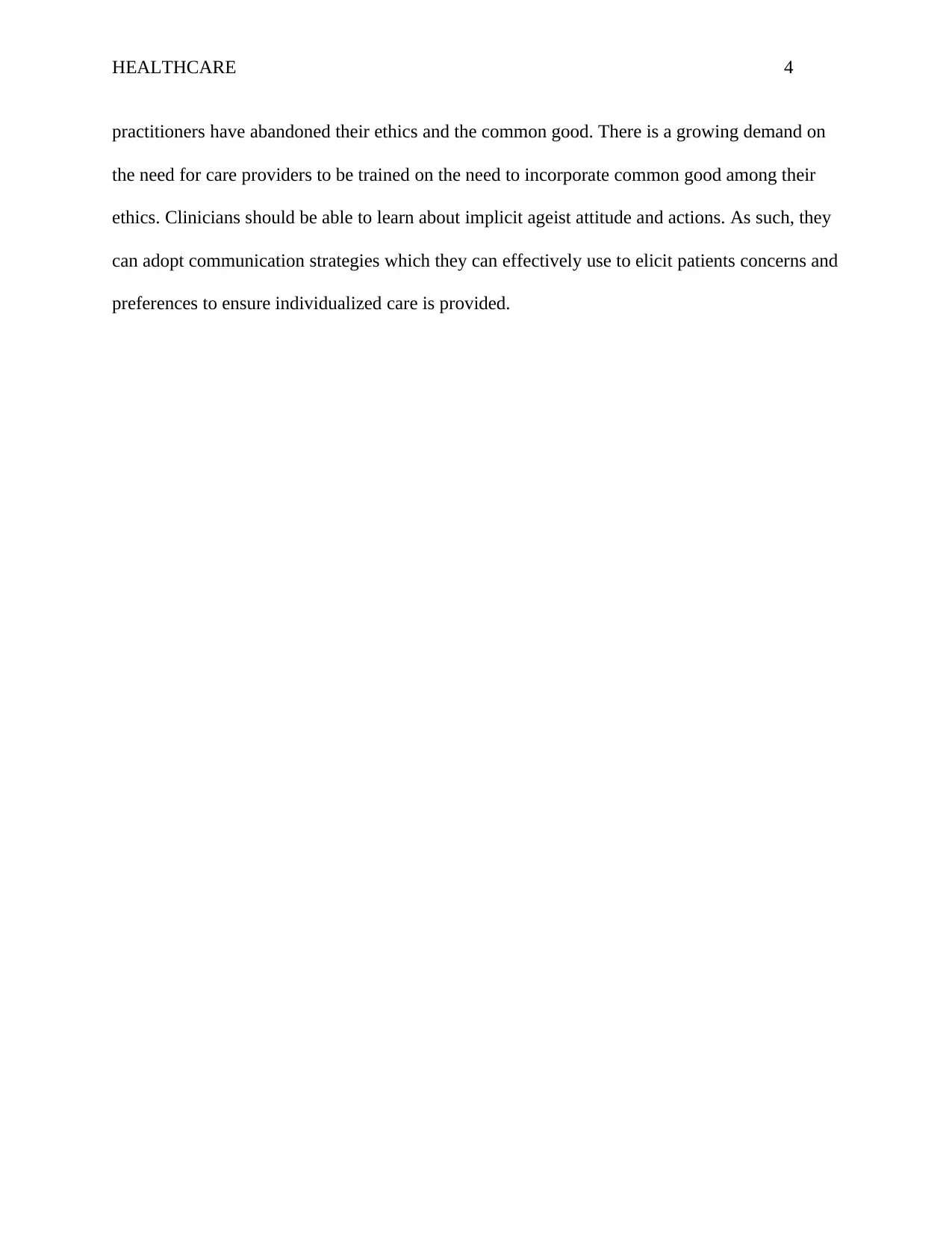
HEALTHCARE 4
practitioners have abandoned their ethics and the common good. There is a growing demand on
the need for care providers to be trained on the need to incorporate common good among their
ethics. Clinicians should be able to learn about implicit ageist attitude and actions. As such, they
can adopt communication strategies which they can effectively use to elicit patients concerns and
preferences to ensure individualized care is provided.
practitioners have abandoned their ethics and the common good. There is a growing demand on
the need for care providers to be trained on the need to incorporate common good among their
ethics. Clinicians should be able to learn about implicit ageist attitude and actions. As such, they
can adopt communication strategies which they can effectively use to elicit patients concerns and
preferences to ensure individualized care is provided.
Paraphrase This Document
Need a fresh take? Get an instant paraphrase of this document with our AI Paraphraser
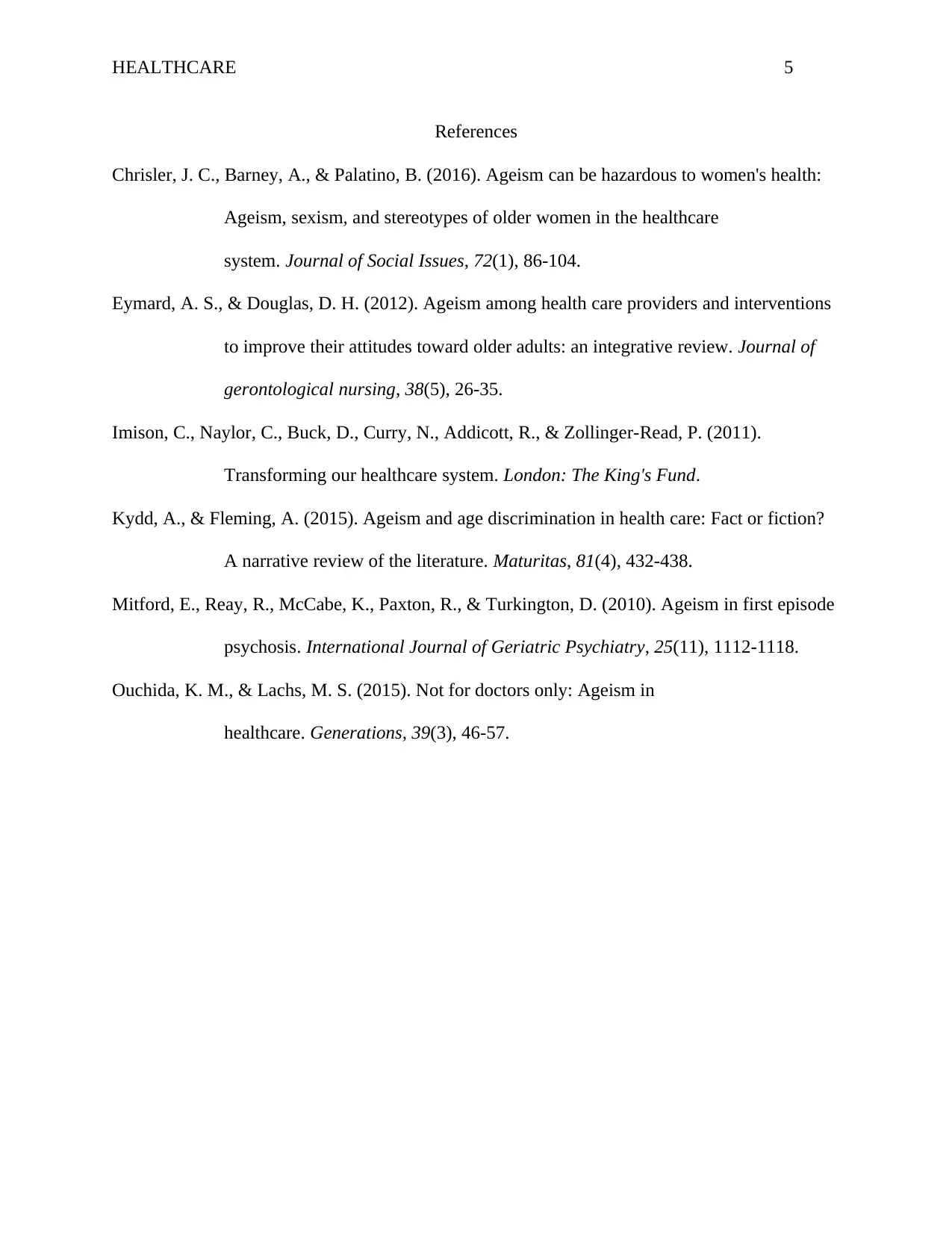
HEALTHCARE 5
References
Chrisler, J. C., Barney, A., & Palatino, B. (2016). Ageism can be hazardous to women's health:
Ageism, sexism, and stereotypes of older women in the healthcare
system. Journal of Social Issues, 72(1), 86-104.
Eymard, A. S., & Douglas, D. H. (2012). Ageism among health care providers and interventions
to improve their attitudes toward older adults: an integrative review. Journal of
gerontological nursing, 38(5), 26-35.
Imison, C., Naylor, C., Buck, D., Curry, N., Addicott, R., & Zollinger-Read, P. (2011).
Transforming our healthcare system. London: The King's Fund.
Kydd, A., & Fleming, A. (2015). Ageism and age discrimination in health care: Fact or fiction?
A narrative review of the literature. Maturitas, 81(4), 432-438.
Mitford, E., Reay, R., McCabe, K., Paxton, R., & Turkington, D. (2010). Ageism in first episode
psychosis. International Journal of Geriatric Psychiatry, 25(11), 1112-1118.
Ouchida, K. M., & Lachs, M. S. (2015). Not for doctors only: Ageism in
healthcare. Generations, 39(3), 46-57.
References
Chrisler, J. C., Barney, A., & Palatino, B. (2016). Ageism can be hazardous to women's health:
Ageism, sexism, and stereotypes of older women in the healthcare
system. Journal of Social Issues, 72(1), 86-104.
Eymard, A. S., & Douglas, D. H. (2012). Ageism among health care providers and interventions
to improve their attitudes toward older adults: an integrative review. Journal of
gerontological nursing, 38(5), 26-35.
Imison, C., Naylor, C., Buck, D., Curry, N., Addicott, R., & Zollinger-Read, P. (2011).
Transforming our healthcare system. London: The King's Fund.
Kydd, A., & Fleming, A. (2015). Ageism and age discrimination in health care: Fact or fiction?
A narrative review of the literature. Maturitas, 81(4), 432-438.
Mitford, E., Reay, R., McCabe, K., Paxton, R., & Turkington, D. (2010). Ageism in first episode
psychosis. International Journal of Geriatric Psychiatry, 25(11), 1112-1118.
Ouchida, K. M., & Lachs, M. S. (2015). Not for doctors only: Ageism in
healthcare. Generations, 39(3), 46-57.
1 out of 5
Related Documents
Your All-in-One AI-Powered Toolkit for Academic Success.
+13062052269
info@desklib.com
Available 24*7 on WhatsApp / Email
![[object Object]](/_next/static/media/star-bottom.7253800d.svg)
Unlock your academic potential
Copyright © 2020–2025 A2Z Services. All Rights Reserved. Developed and managed by ZUCOL.





